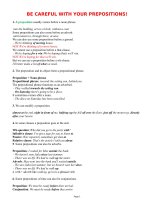GOLFING WITH YOUR EYES CLOSED pdf
Bạn đang xem bản rút gọn của tài liệu. Xem và tải ngay bản đầy đủ của tài liệu tại đây (1.74 MB, 206 trang )
GOLFING
CLOSED
EYES
WITH
YOUR
This page intentionally left blank
ERIN MACY AND TIFFANY WILDING-WHITE
GOLFING
CLOSED
EYES
WITH
YOUR
Mastering Visualization
Techniques for
Exceptional Golf
New York Chicago San Francisco Lisbon London Madrid Mexico City
Milan New Delhi San Juan Seoul Singapore Sydney Toronto
Copyright © 2009 by Erin Macy and Tiffany Wilding-White All rights reserved. Except as permitted under
the United States Copyright Act of 1976, no part of this publication may be reproduced or distributed in any
form or by any means, or stored in a database or retrieval system, without the prior written permission of the
publisher.
ISBN: 978-0-07-161508-2
MHID: 0-07-161508-3
The material in this eBook also appears in the print version of this title: ISBN: 978-0-07-161507-5, MHID:
0-07-161507-5.
All trademarks are trademarks of their respective owners. Rather than put a trademark symbol after every
occurrence of a trademarked name, we use names in an editorial fashion only, and to the benefit of the trade-
mark owner, with no intention of infringement of the trademark. Where such designations appear in this book,
they have been printed with initial caps.
McGraw-Hill eBooks are available at special quantity discounts to use as premiums and sales promotions, or
for use in corporate training programs. To contact a representative please visit the Contact Us page at
www.mhprofessional.com.
Interior photographs for chapters 1, 6, and 7 by John Macy. Interior photographs for chapters 4, 5, 8, and 9
by Erin Macy. Interior photograph for chapter 2 by Eric King. Interior photograph for chapter 3 by Gary
Allen.
TERMS OF USE
This is a copyrighted work and The McGraw-Hill Companies, Inc. (“McGraw-Hill”) and its licensors reserve
all rights in and to the work. Use of this work is subject to these terms. Except as permitted under the
Copyright Act of 1976 and the right to store and retrieve one copy of the work, you may not decompile, dis-
assemble, reverse engineer, reproduce, modify, create derivative works based upon, transmit, distribute, dis-
seminate, sell, publish or sublicense the work or any part of it without McGraw-Hill’s prior co sent. You may
use the work for your own noncommercial and personal use; any other use of the work is strictly prohibited.
Your right to use the work may be terminated if you fail to comply with these terms.
THE WORK IS PROVIDED “AS IS.” McGRAW-HILL AND ITS LICENSORS MAKE NO GUARANTEES
OR WARRANTIES AS TO THE ACCURACY, ADEQUACY OR COMPLETENESS OF OR RESULTS TO
BE OBTAINED FROM USING THE WORK, INCLUDING ANY INFORMATION THAT CAN BE
ACCESSED THROUGH THE WORK VIA HYPERLINK OR OTHERWISE, AND EXPRESSLY DIS-
CLAIM ANY WARRANTY, EXPRESS OR IMPLIED, INCLUDING BUT NOT LIMITED TO IMPLIED
WARRANTIES OF MERCHANTABILITY OR FITNESS FOR A PARTICULAR PURPOSE. McGraw-Hill
and its licensors do not warrant or guarantee that the functions contained in the work will meet your require-
ments or that its operation will be uninterrupted or error free. Neither McGraw-Hill nor its licensors shall be
liable to you or anyone else for any inaccuracy, error or omission, regardless of cause, in the work or for any
damages resulting therefrom. McGraw-Hill has no responsibility for the content of any information accessed
through the work. Under no circumstances shall McGraw-Hill and/or its licensors be liable for any indirect,
incidental, special, punitive, consequential or similar damages that result from the use of or inability to use
the work, even if any of them has been advised of the possibility of such damages. This limitation of liabili-
ty shall apply to any claim or cause whatsoever whether such claim or cause arises in contract, tort or other-
wise.
To John. Thank you for your unconditional
commitment and confidence in me.
—E.M.
To Mom and Dad, for sharing with me
the love of life.
And to Carter, the love of my life.
—T.W.
This page intentionally left blank
vii
CONTENTS
Acknowledgments . . . . . . . . . . . . . . . . . . . . . . ix
An Introduction to the Fifteenth Club:
The Path to Peak Performance . . . . . . . . . . . . . xi
THE FIRST HOLE Your Ace in the Hole . . . . . . . . . . . . . . . . . . . . . 1
THE SECOND HOLE Visualization in Action . . . . . . . . . . . . . . . . . . . 15
THE THIRD HOLE Power of the Positive Mind . . . . . . . . . . . . . . . . 35
THE FOURTH HOLE Consistency Under Pressure . . . . . . . . . . . . . . . 57
THE FIFTH HOLE Your Internal Driver . . . . . . . . . . . . . . . . . . . . . 87
THE SIXTH HOLE Life’s Lessons . . . . . . . . . . . . . . . . . . . . . . . . . 111
THE SEVENTH HOLE Sample Golf Visualization Scripts . . . . . . . . . 123
THE EIGHTH HOLE Design Your Own Visualization Scripts . . . . . 147
THE NINTH HOLE How Far Have You Come? . . . . . . . . . . . . . . . 157
References . . . . . . . . . . . . . . . . . . . . . . . . . . . 169
Bibliography . . . . . . . . . . . . . . . . . . . . . . . . . . 175
Index . . . . . . . . . . . . . . . . . . . . . . . . . . . . . . . 179
This page intentionally left blank
ix
ACKNOWLEDGMENTS
I
n writing Golfing with Your Eyes Closed: Master-
ing Visualization Techniques for Exceptional Golf,
we appreciate the enthusiasm, expertise, and edit-
ing shared by those close to us. Thank you to our
most amazing and supportive husbands, John and
Carter, who are also our biggest fans.
Our thanks go to those whose expertise in golf contributed to the
writing of this book: Michael Greller, Tom Greller, MaryJo McCloskey,
Tim Hyatt, Matt Beck, Christine Collier, and Rob and Melissa O’Neill.
To our editor, Ron Martirano, for his belief in our project, and to Alexis
Hurley for her time and professional insight. Many others gave valued
advice along the way: Dr. Dan Benardot, Lori Blair, Madeleine Blais,
Michelle Choy, Dr. Keith Henschen, and Dan McCracken.
To our incredible editing team: Sherry Macy, Vicki Sanders, and
Debby and Bill Winslow. It’s in the genes.
To our classmates Amy, Brian, Chris, and Dan, who were part of
the original project and to Dr. Greg Shelley for the initial inspiration.
George Fox University was generous to provide many of the photos
sprinkled throughout the book.
Through it all, we are thankful for our friends, especially Julie and
the Newberg family, for their interest and cheerleading in what we’ve
been working to complete. And always, to our families, for their con-
stant love, encouragement, and positive influence in our lives.
This page intentionally left blank
xi
AN INTRODUCTION
TO THE FIFTEENTH
CLUB
The Path to Peak Performance
Success in golf depends less on strength of body
than upon strength of mind and character.
—ARNOLD PALMER
1
T
rophies, titles, new records, personal bests,
satisfaction, and strong social relation-
ships—nearly every athlete strives for
these. In this book, we give you the keys
to mental success in golf. Certainly, real
success requires a good handle on both your physical and mental game. No
one gets very far without a light grip, balanced stance, and mastery of basic
swing mechanics, but we’re leaving the physical aspects up to you and your
golf instructor. The mental skills—the so-called fifteenth club that most
players and experts know constitutes more than 80 percent of the game—
are all in here. The trick is to combine your physical prowess with mental
imagery. This powerful duo can take you to new heights in performance.
We have written Golfing with Your Eyes Closed as a mental train-
ing program for golfers of all levels. The material can easily be applied
by everyone, from beginners to scratch golfers to pros. The wording is
straightforward and casual, making it fun and simple to understand. At
whatever level you play golf, learning to add or refine mental imagery and
visualization to your game will help you reach your peak performance.
Our aim in creating Golfing with Your Eyes Closed is to provide
you with complete information on what it takes to consistently play the
best golf you can on the course. We hope you will gain new and useful
information from this book and then implement what you learn the very
next time you tee off. While you probably have already heard something
about the effectiveness of mental imagery, you will find the detailed
xii AN INTRODUCTION TO THE FIFTEENTH CLUB
how-to here in this book. It offers exercises for you to try, key points to
remember, a series of tips for coaches and players, and anecdotes as well
as personal advice from instructors and players. You’ll meet Christine, a
National Collegiate Athletic Association (NCAA) golfer who has learned
to refocus after missing a shot. You’ll meet Matt and Mary Jo, collegiate
coaches who develop leaders on their golf teams. We’ll introduce you to
avid golfers Tom, Michael, and Tim, who are always looking for ways
to take their game to the next level, and to Bill, a retired businessman
whose positive-thinking skills help him on and off the course. How do
we know it will work? Because the difference between two equally well-
trained players draining the putt or lipping out lies in the strength of
their mental control.
Visualization, or imagery, as we also call it, is the equivalent of play-
ing movies in your head. You can see, feel, hear, and even smell and taste
the elements of the perfect round of golf. Time and again, you’ll observe
high-level players using mental rehearsal to increase their confidence,
sharpen their concentration, control their nerves, and strengthen their
motivation. Mental imagery is one of the most powerful tools for perfor-
mance enhancement. By experiencing your performance in your mind,
you can see marked improvement in your performance on the course.
With training and practice, you can master this mental skill and imple-
ment it easily and consistently.
Visualization has numerous applications: it can be used to pre-
vent errors, correct mistakes, enhance consistency, strengthen muscle
memory, assess and perfect your swing’s appearance and feeling, calm
and energize, encourage healing, and promote success. Imagery can be
highly beneficial. So how do you get good at it?
By following this book, you will:
→
assess your current imagery patterns
→
learn the benefits and uses of imagery
→
understand the theories behind why visualization works
→
practice imagery to feel how it affects your muscle memory
→
learn how to consistently turn nervous energy into positive performances
→
concentrate and avoid choking under pressure
→
refocus after a concentration lapse and between shots
→
identify what motivates you
→
establish a M.A.S.T.E.R. goal-setting program to build golf-specific
motivation
→
create your own personal goal achievement plan to help you realize your
golf ambitions
xiiiAN INTRODUCTION TO THE FIFTEENTH CLUB
→
discover how to develop a consistently positive mind-set
→
design your own personal imagery routines and scripts
→
apply your new mental skills on and off the course
→
assess your progress, and create concrete and attainable plans for contin-
ued improvement in golf
Imagine—you’re just steps away from playing a better game of golf!
What separates the best of us from the rest of us? Mental sharp-
ness. Reading and implementing the exercises in Golfing with Your Eyes
Closed can pave the path to your peak performance. We provide the
keys; you provide the drive. Champions go to sleep at night visualizing
their best performances, and they wake up determined to turn their
visions into reality. By practicing mental imagery, you can be a cham-
pion in your golf game, too.
SELF-ASSESSMENT SCORECARD
The first step in being able to “golf with your eyes closed” is to deter-
mine how you use visualization, the strength of your mental muscle, and
where you will most benefit from learning some new skills. You may
never have used visualization before. Maybe you visualize by following
an imaginary ball along its path to your target. Or you may try to visu-
alize during tournament play. Regardless of your experience, take time
to answer the self-assessment questions that follow. Doing so will give
you a baseline by which you can measure your improvement as you learn
how to visualize and begin to practice.
Imagine that each question is set up as a par-three hole. Assign a
number value for your answers according to the provided scale, marking
answers to questions 1–18 in the initial assessment line of the Self-
Assessment Scorecard on page xvi. These questions and your responses
will be referred to throughout the book.
1 = Consistently (eagle)
2 = Mostly (birdie)
3 = Sometimes (par)
4 = Rarely (bogey)
5 = Never (double bogey)
1. I visualize on the driving range and while at home or work.
2. I visualize my shots before and during a round of golf.
xiv AN INTRODUCTION TO THE FIFTEENTH CLUB
3. In my imagery, I see myself performing from an outside perspective, as if
through a video camera (externally).
4. In my imagery, I see myself performing from my own viewpoint
(internally).
5. The colors and visual surroundings of my images are clear and detailed.
6. The sounds during my performance are sharp and audible in my mental
rehearsal.
7. I can change my images in my mind to reflect my desired performance.
8. I use a pre-shot routine when I take a full shot.
9. When playing golf, I am positive and in control of my emotions.
10. I am confident with each shot I take.
11. I effectively shut out negative thoughts.
12. I play well under pressure.
13. After every shot, I am able to mentally leave behind whatever I just did
and begin to focus fully on my next shot.
14. To help me concentrate and avoid choking, I use relaxation techniques
like visualization and deep breathing.
15. It’s easy for me to relax between shots and then to regain my focus as
needed.
16. I have very specific goals for golf and a detailed plan to achieve them.
17. The main reason I play is for pure enjoyment, not for rewards like money,
fame, or business gains.
18. Both on the course and off, I find myself visualizing many different sce-
narios, from school or business to public speaking or other performances.
Questions 19–24 assess your general visualization, motivation, con-
centration, and confidence patterns. Write your responses in the area
provided.
19. If you have ever visualized, when did you do it? (At night? During your trip
to the course? Before every shot?) Note how consistent you are.
xvAN INTRODUCTION TO THE FIFTEENTH CLUB
20. Where can you image most clearly? (While lying in bed with your eyes
closed? At the range? At a particular hole on your home course?)
21. Do you usually visualize an entire round, from shot to shot, in order, and
all the way through? Or just some key elements? Describe the scenes you
usually visualize.
22. In which circumstances do you feel most affected by nerves?
23. Imagine that you’re cursing over a bad shot or thinking about what you’re
going to do after the round. In such a case, what would you usually do to
bring your focus back to the present shot?
xvi AN INTRODUCTION TO THE FIFTEENTH CLUB
24. Which specific parts of your game are you hoping to improve by complet-
ing the exercises in this golfer’s mental training guide?
Golfing with Your Eyes Closed Self-Assessment Scorecard
QUESTION 123456789101112131415161718TOT
PAR 333333333333333333 54
INITIAL ASSESSMENT
1 MONTH
2 MONTHS
3 MONTHS
6 MONTHS
9 MONTHS
1 YEAR
SCORER:
xviiAN INTRODUCTION TO THE FIFTEENTH CLUB
Add up your scores from questions 1–18 on the Self-Assessment
Scorecard. If your totals were:
→
66–90: As a newcomer to visual mental training techniques, you will notice
a significant improvement in performance by incorporating the basic les-
sons of Golfing with Your Eyes Closed into your game on a regular basis.
Visualization is a skill that takes practice, so let’s get going! Don’t be over-
whelmed by everything you read here. Take it one step at a time, and make
sure you really understand each concept before moving onto the next one.
There’s no need to rush—just like in your golf game, it’s important to take
the time to line up your mental shots. With patience and practice, you will
definitely see improvements in your ability to visualize on the course.
→
37–65: Having experience in visualization, you should find your game
becoming more consistent as you learn to visualize consistently. By imple-
menting the exercises presented throughout, you’ll enjoy the game more
and lower your score as you play. As you find areas where you are not as
strong, take extra care to complete all the exercises and to integrate the
visualization training tips into your game.
→
18–36: As a skilled visualizer, you may have a pretty good handle on
visualization and its usefulness in performance enhancement. But there’s
always room for improvement. Within this book, you’ll find effective meth-
ods to hone and sharpen your mental skills to take your game to a higher
level. Each exercise is adaptable to your level of mental and physical ability.
Even tour players constantly seek out different exercises to help advance
their mental play.
As you read through the chapters, we’ll touch on these questions
again. Keep your answers close at hand for easy reference. Once you are
finished with the book and have begun implementing our advice, use
the Self-Assessment Scorecard periodically to evaluate improvements
in your visualization ability as you put into practice the methods and
instruction from this book.
This page intentionally left blank
GOLFING
CLOSED
EYES
WITH
YOUR
This page intentionally left blank
1
1
Your Ace
in the Hole
1
1
1
THE FIRST HOLE
2 GOLFING WITH YOUR EYES CLOSED
M
ichael is an amateur golfer whose mind often gets the
better of him in the game. He has had a difficult summer
on the course, losing to his rivals nearly every round.
Often, it takes just one mistake to break his rhythm,
leading to more mental errors and missed shots.
Michael knows the value of visualization and has
tried off and on to implement it in his game. As an important tourna-
ment approaches, he begins to practice it more consistently, seeing each
stroke in his mind’s eye before he makes it. At home, off the course, he
pictures himself at the tournament and in a variety of situations on each
hole.
The day of the tournament arrives, and Michael is feeling confident,
believing in his ability to be near the top of the leaderboard. He arrives
at the course at his usual forty-five minutes ahead of time and runs
through his warm-up routine. Ready but anxious, Michael steps into the
first tee box, going through the motions he has practiced so many times.
He drives through the ball. It carries over a small ridge and comes to rest
on the fairway. He’s off to a great start! His approach shot lands him
on the green within range for a sinkable putt, and he is feeling good. He
lines up for an easy putt and blows it five feet past the hole. Frustrated,
Michael uses an extra minute to collect himself, taking the time to go
through his visualization routine and even seeing his name on the lead-
erboard. He addresses the ball for his second putt, repeating his mental
mantra to himself. Body balanced, he gently strikes the ball. He hears
the ball hit the bottom of the cup, and his confidence returns.
TEEING OFF
In your own golf game, you’ve probably felt the frustration of blowing
an easy putt and wondered, “How could I have missed that?” Logic tells
you that your lineup was accurate, your read of the green was right on,
and your stroke was smooth. But reality shows that something went
awry. Most likely, it was your mental composure. Like Michael in the
previous example, you may have rushed a little instead of slowly taking
each step in your pre-shot routine. By learning to visualize, you increase
the likelihood of making more shots more regularly, because you become
sharply focused on the exact actions required to consistently hit your
target.
This first chapter introduces you to the basics of visualization and
gets you started on a plan of action. The theories, examples, and exer-
cises here help you:
3THE FIRST HOLE: YOUR ACE IN THE HOLE
→
understand the different forms of visualization
→
practice both external and internal imagery at appropriate times
→
focus on the positive images and block out negative pictures
→
keep in mind the theories that govern visualization’s power over your game
→
replace thinking with visualization on the course
→
integrate the elements that make images come to life
You may want to consider the exercises that follow in this chapter to
be as important as your pregame preparations. You wouldn’t play golf
without first taking out your clubs, tying your golf shoes, and putting
on your glove. This chapter, like those rituals, is both basic and essential
to playing your best.
IMAGERY’S INNER WORKINGS
In the movie The Greatest Game Ever Played, two different styles of
visualization are portrayed. Harry Vardon brilliantly erases every dis-
traction surrounding him—the crowd, the noise, and even the trees
lining the fairway. He wipes these images out and sees only his target.
Francis Ouimet, on the other hand, cre-
ates a picture of the hole being extremely
large by making his mind zoom in and
fixing his aim on this one point.
1
Other
players use different techniques. Jack
Nicklaus talked about seeing the shot take
form before he even addressed the ball,
and Sam Snead compared visualization to
painting a picture of the shot he planned
to hit.
2
Imagery comes in many forms, and
this section should help you determine the
most beneficial form for your golf game.
Forms of Visualization
Visualization can be external or internal.
If you practice visualizing externally, you
see yourself from an observer’s view, as
if watching a video of your performance.
Visualizing internally, you see yourself
executing a skill through your own eyes—
what you actually see when performing.
For example, a golfer visualizing herself
I
never hit a shot, not even
in practice, without having
a very sharp, in-focus
picture of it in my head. First
I see the ball where I want it
to finish, nice and white and
sitting up high on the bright
green grass. Then the scene
quickly changes, and I see
the ball going there: its path,
trajectory, and shape, even
its behavior on landing. Then
there is a sort of fade-out,
and the next scene shows me
making the kind of swing that
will turn the previous images
into reality.
—JACK NICKLAUS
3
4 GOLFING WITH YOUR EYES CLOSED
teeing off from an external perspective sees her feet shoulder-width
apart; arms, chest, and hands coming together to form a triangle; her
head tilted at an angle; and her eyes focusing on the ball. From an inter-
nal perspective, however, she only sees the tee and the ball, the grass
underfoot, her feet, and in her peripheral vision she may see the natural
surroundings of the course.
Your answers to questions 3 and 4 of the Self-Assessment Scorecard
show you how you visualize.
COACH’S CORNER
Try this exercise to help your players learn the power of imagery: Tie a
weight to the end of a string six to twelve inches long. Have them hold
the end of the string, close their eyes, and keep their hand and arm
perfectly still. Ask them to visualize the string and weight swinging like
a pendulum, back and forth, back and forth. Lead them through this
for about one minute. When they open their eyes, the string will actu-
ally be swinging, convincing them of the strength of their mind-body
connection. This should really wow them!
External visualization is used to assess how a stroke looks to an
observer. It allows you to analyze your body positions, thereby enabling
you to correct mistakes and refine your movements. On the other hand,
internal imagery is used to assess how your swing feels. Repeatedly
visualizing from your own perspective helps internalize the feeling of a
stellar performance. Once you can see and feel your mistakes or fears,
you can correct them by mentally rehearsing the right technique instead.
Regularly creating images of the performance you hope to achieve equips
you to execute under pressure.
Try it! Let’s imagine the same scene from two different viewpoints.
First, close your eyes and visualize externally: You stand on the green,
alone, wearing a collared shirt and pants and carrying your putter.
Other golfers watch you from the edge of the green. They are com-
pletely silent as you take your time examining the green and lining up
your putt. You approach the ball, align your body, and take a practice
swing. Take your normal stance and address the ball. Like a pendulum,
your arms swing and you strike the ball. Watch the ball travel across the
green and drop into the hole.
Now try visualizing this same scene from your own internal
perspective.
Notice the differences. From an external perspective, you probably
saw the other golfers, your putter in your hands, and the contours of the









